Checking a Used 1911 with a Purchase in Mind
Prelude: Make sure the pistol is unloaded. Lock back the slide and check the chamber. Put a finger on top of the magazine follower and across the chamber. Look again. Make sure the pistol is unloaded. During all of this inspection process, keep the muzzle in a safe direction.
#1 Check Originality.
Know what the pistol should look like.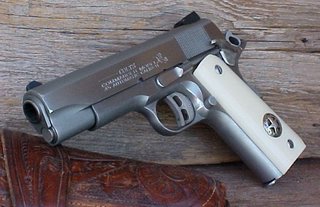 Know what the markings on the frame and slide should be and where they should be located. There are many mix master pistols out there, and some are quite good. Essex is not a secret Colt foundry in Area 51 though. Non-original small parts that can be recified do not necessarily lower the price of a pistol, nor do well installed aftermarket parts that work right if the buyer wants that modification. However, they do show that someone has been monkeying around with the pistol, and other inspections should be carried out more stringently. On a collector's piece, they DO lower the value, and should have replacement cost deducted from the price accordingly. We are talking buying shooting pistols here though, not collector's guns.
Know what the markings on the frame and slide should be and where they should be located. There are many mix master pistols out there, and some are quite good. Essex is not a secret Colt foundry in Area 51 though. Non-original small parts that can be recified do not necessarily lower the price of a pistol, nor do well installed aftermarket parts that work right if the buyer wants that modification. However, they do show that someone has been monkeying around with the pistol, and other inspections should be carried out more stringently. On a collector's piece, they DO lower the value, and should have replacement cost deducted from the price accordingly. We are talking buying shooting pistols here though, not collector's guns. #2 Check For Damage
The seller should let you field strip the pistol. If he does not, pass on it. Period. There is no reason to refuse this on a used gun except to conceal damage.Once inside the gun, bring the frame and slide rails up to eye level and check them for straightness like you would a piece of lumber. A bulge on both sides of an area means this gun has suffered a KaBoom. Likewise, run the barrel between your fingers, checking for bulges. Check the bore. Check the barrel and slide lugs for damage and peening. Check the barrel seat for proper fit and signs of impact. Check the breech face and barrel hood for peening. Check the slide for cracks at the beginning of the recoil plug tunnel. Check the frame for cracks at the beginning of the dustcover and the slide stop hole. Some guns with a hole where the rear of the slide stop enters the frame will be cracked in the frame rail above the hole. This is so common that many newer guns have the rail cut out here. A crack in this area is not a cause for alarm in a shooter, but can be a bargaining chip on the price. It is easily repaired by cutting out the crack. Look for signs of an incompetent person using tools inside the pistol. The finish should show normal wear on the rails, breech face, barrel and slide lugs, and other moving parts. Holster wear is OK. In fact, it is a common sign of a gun that works as advertised. Signs of impact from tools, especially around the right slide stop hole are signs of incompetent monkeys with tools in possession of this pistol. A stripped magazine lock screw is a sign of the same.
#3 Check Functions
The slide should pull back easily, without any change in resistance along the length of it's travel. It should lock back quickly and positively with the magazine inserted. Try this both with and without the magazine checking for smoothness of travel.
Try this both with and without the magazine checking for smoothness of travel. A Wilson Combat or genuine Colt magazine should insert and lock positively, and fall free upon release, without resistance. It should not rattle in the gun. You may want to bring your own along for this check, as used guns are often sold with cheapo magazines. If the gun has an extended ejector, the magazine should not touch it when inserted.
Ask if it is OK to release the slide from slide lock. This will not harm a 1911 if not done over and over. If it is OK with the owner, remove the magazine with the pistol at slide lock. Place your left thumb on the slide lock and release the slide. The hammer should not follow the slide. Check this one more time. Then, with the hammer still cocked and your finger off the trigger, try to push it off the sear. If the hammer falls in any of these instances, the gun is not safe to load with live ammo until repaired. If the seller balks at this test, pull a snap cap out of you pocket to perform it with. The test will not be as stringent with a snap cap, but if the gun fails with a snap cap, it will certainly fail without one. If the seller balks at the use of a snap cap for the test, pass on the gun.
The thumb safety should snick on and off without resistance in either direction with the hammer cocked. The hammer should not move when engaging the thumb safety. Once engaged, press on the trigger a couple of times with the grip safety depressed. Then raise the rear of the pistol up to your ear and slowly pull back on the hammer. Listen for a little tink sound. If you hear this sound, the thumb safety is allowing the sear to move on the hammer hooks while engaged. Replacement of the thumb safety or sear will be in order.
The grip safety should not allow the trigger to be moved when not depressed. When depressed, it should offer no resistance to the trigger.
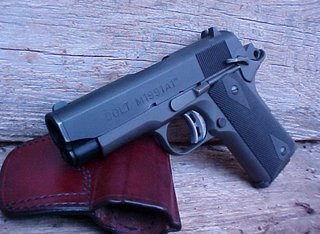 Depress the grip safety, pull the trigger back and hold it. Release the grip safety. Then release the trigger. The trigger and grip safety should both pop back out quickly and smoothly.
Depress the grip safety, pull the trigger back and hold it. Release the grip safety. Then release the trigger. The trigger and grip safety should both pop back out quickly and smoothly. With the hammer cocked and thumb safety off, use your weak hand to hold the slide about 1/8 inch out of battery while pulling the trigger. The hammer should not fall. If it does, the disconnector is worn or monkeyed with, and you may be holding a full auto 1911.
Ask to dry fire the gun. The trigger should release the hammer at a poundage suitable for your likes or greater. Greater poundage than required can be reduced without parts replacement. Making a light trigger heavier often involves new parts. The trigger should be smooth throughout it's travel, and the sear should break cleanly. Once dry fired, lock the slide back and take a look at the breechface. The firing pin should be retracted.
Insert a Bic-Stick type ball point pen into the barrel, plastic end first. Cock and drop the hammer with the barrel pointed straight up. The pen should fly out of the gun at least two feet. Any less is a sign of a weak mainspring, or a sign of firing pin damage.
#4 Check Fittment
On some pistols, such as a Colt, some lateral movement of the slide in battery is acceptable. Unless it is a match grade top of the line gunsmithed pistol, it is expected. The pistol may rattle a bit if shook vigorously from side to side and still be accurate. Other pistols, such as a Les Baer are expected to lock up tighter than Fort Knox.The rear of the slide should blend smoothly into the frame. Neither the ejector nor the extractor should be above or below the surface. The trigger should not flop around sloppily in it's track. The magazine release should be flush on the right side with a magazine inserted.
Many people evaluate barrel lock-up by pressing on the barrel hood in battery. Movement is considered to be bad. While a firm lock-up is nice, of greater importance is whether the barrel returns to the same location with each slide cycle. The muzzle end of the barrel should not move within the bushing. The slide should not have wear on the muzzle end that passes into the dustcover on recoil.
#5 Evaluating Modifications
If the pistol has any modifications, they should be well done.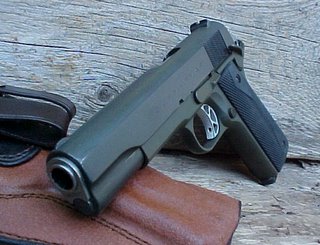 I look at the fit of aftermarket grip safeties, especially the way the lines of the pistol was blended into the line of the grip safety. If the rear of the frame has humps in it where it was blended, the gunsmith did not have an eye for quality. The gap between grip safety and frame should be no greater than the thickness of a piece of paper. The grip safety should not rub on either side of the frame.
I look at the fit of aftermarket grip safeties, especially the way the lines of the pistol was blended into the line of the grip safety. If the rear of the frame has humps in it where it was blended, the gunsmith did not have an eye for quality. The gap between grip safety and frame should be no greater than the thickness of a piece of paper. The grip safety should not rub on either side of the frame. If it has an aftermarket bushing, I remove it and check that for fit too. A correctly fit bushing should not require a bushing wrench for removal. It should not require a hammer for installation.
Aftermarket extended thumb safeties should snick on and off without mushiness or resistance. I check the underside of the left side of the slide to see if the thumb safety has been battering it. The apex of the thumb safety should be at least 1mm below the slide at rest.
An aftermarket barrel should have no peening on the hood, or the lugs. The slide of such a gun as well as the frame should be checked as well. A well fitted, quality aftermarket barrel (assuming good rifling) is always a plus for me.
Look at the sights. Quality sights with a professional installation are a big plus for me. Sights that look like Bubba bought them on sale at a gun show and installed them with a rock are not. Adjustable sights that are off center make me wonder why.
A refinished gun is not necessarly an indicator of a worn out gun.
 Many pistols are refinished after customization is completed. Some finishes, such as hard chrome enhance the durability of the gun. Others like a home baked Gun Kote job may not last long. One thing to consider is that a refinish (assuming it's not 24 kt. gold) should never add to the cost of the gun, but a bad refinish can subtract from it. A good finish is expected. The same applies to grips. If the price is being jacked up because of them, ask to buy the gun without them, unless they are factory ivory. If you want them, and they are not ivory, they should not add to the price of the gun. Ugly or dinged up grips subtract from the price.
Many pistols are refinished after customization is completed. Some finishes, such as hard chrome enhance the durability of the gun. Others like a home baked Gun Kote job may not last long. One thing to consider is that a refinish (assuming it's not 24 kt. gold) should never add to the cost of the gun, but a bad refinish can subtract from it. A good finish is expected. The same applies to grips. If the price is being jacked up because of them, ask to buy the gun without them, unless they are factory ivory. If you want them, and they are not ivory, they should not add to the price of the gun. Ugly or dinged up grips subtract from the price. A non-original full length guide rod and an extended slide stop are red flags to me. They tell me the last owner did not understand this pistol very well. Conversely, a pistol that came with a FLGR but now presents with a GI set-up tells me the last owner knew the gun. Known cheapo aftermarket parts (they are easy to spot) tell me the last owner had a ghetto mentality about the gun.
Often I will be told "This gun was done by (insert name of reknowned 'smith")". It pays to be able to recognize quality work, and to know what different people's work often looks like. Suffice to say, a gun that has passed through a reknowned gunsmith's hands should have an appearance and function several degrees above what the factory puts out, regardless of who makes the gun. It should NEVER look worse than a top of the line gun. These men do not put out trash. Many less than stellar gunsmiths do. Which brings us to item #5.
#5b Spotting Incompetent Work
People love to fiddle with a 1911. It's hard not to. It looks so easy. It's not.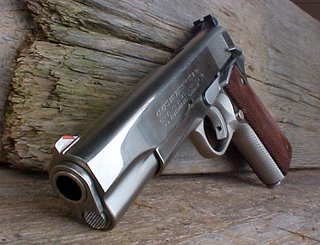 It is easier to screw up a 1911 than to "improve" one.
It is easier to screw up a 1911 than to "improve" one. The first thing that jumps out at me is buggered up grip screws. If a man cannot use a screwdriver, he is not mechanically equipped to open up a 1911. 'nuff said.
Next I look at the feed ramp with the slide locked back. There should be about a 2mm step between the bottom of the barrel and the top of the feed ramp on a Government Model. Incompetent gun hacks love to take a Dremel to the feed ramp of 1911's. If this step is not present, the gun will never feed ammo properly, and it cannot be repaired for less than the cost of a frame replacement.
I look at lowered ejection ports for the straightness of the lines. The scallop behind the ejection port should have smooth edges and be in the right place.
I look at the sights for signs of heavy handed handiwork. Punch marks around the sights and the slide stop hole, as well as stripped mag release screws and pins inserted backwards are red flags.
#6 Shooting the Pistol
One of the advantages of buying used is the ability to test fire the gun without lowering it's value in the marketplace Many sellers will allow you to fire their gun if they percieve you as a serious buyer. It never hurts to ask. Offer the owner a "test target" to help him in his sale if you do not buy. Expect to buy the ammo, and no +P ammo. No reloads from your Brother-in-Law Bernie. Only clean factory ammo, and some JHP if it's a defensive weapon. Somewhere between 50 and 100 rounds. Buy the ammo from the seller if he is a dealer. If he will only let you shoot one magazine "out back" make it your preferred JHP and try your darndest to create a jam. Offer to clean the gun when you are done. The combination of a high dollar guaranteed ammo sale, a decent test target, and a clean gun is often to much to resist if the seller trusts you. Heck, invite him along to shoot your prize Python while he waits.
Offer the owner a "test target" to help him in his sale if you do not buy. Expect to buy the ammo, and no +P ammo. No reloads from your Brother-in-Law Bernie. Only clean factory ammo, and some JHP if it's a defensive weapon. Somewhere between 50 and 100 rounds. Buy the ammo from the seller if he is a dealer. If he will only let you shoot one magazine "out back" make it your preferred JHP and try your darndest to create a jam. Offer to clean the gun when you are done. The combination of a high dollar guaranteed ammo sale, a decent test target, and a clean gun is often to much to resist if the seller trusts you. Heck, invite him along to shoot your prize Python while he waits. Once at the range, I first load three rounds of JHP and shoot them to see if I get hammer follow or a full auto effect. I do this twice, at different speeds.
Then I load a magazine full of JHP and empty it into a target as fast as I can with a limp wrist. For once, I do not care about groups. I am trying to jam the gun. I note where the empties fly. I pick one or two up and check them for centered primer strikes and dents in the case. Then I load up another magazine with JHP and do the same limp wrist procedure, except this time holding the pistol upside down. I do this often enough that the Range Officer knows I am in a buying mood.
I try to fire the pistol with the thumb safety engaged. I try to fire it with the grip safety released. I allow my thumb to ride the slide to see if I can initiate a malfunction.
If the pistol continues to work as advertised,
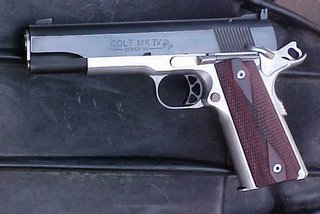 I load up some target rounds and shoot for accuracy. I am not a bullseye shooter, so I usually shoot from sandbags at 15 yards. As long as the pistol performs better than me, I figure it is accurate enough. I shoot several groups of five rounds, and compare consistency as well as accuracy. I try to eliminate any of my own shortcomings from the equation.
I load up some target rounds and shoot for accuracy. I am not a bullseye shooter, so I usually shoot from sandbags at 15 yards. As long as the pistol performs better than me, I figure it is accurate enough. I shoot several groups of five rounds, and compare consistency as well as accuracy. I try to eliminate any of my own shortcomings from the equation. If the pistol has no failures, I clean it, and get to re-examine the interior, but this time with the advantage of fresh soot and cleaning fluid. If the job is done carefully, it can reveal damage that is invisible to the naked eye. Liquified soot will travel right to a crack. A piece of cloth dragged over a part can snag on a burr the finger can not feel.
Finally, let me say that the price of the gun should be agreed on at the counter, before the test fire. You should never use the test fire as a bargaining chip to lower the price. If you do that, the seller will likely never allow you to test fire a gun again, and you might like the next gun even more. The test fire should be seen only as a means to eliminate a potential problem gun before a transfer of ownership. You should only request a test fire if you are prepared to buy right then. If you find a problem that eliminates the gun, explain what you found in good humor. Above all, do not become hostile, but do not waver. If the owner offers a lower price, consider it and take it if you like, but never, never, make him think you are trying to get him to lower the price. At the range, a change in price should always be the seller's option. One more thing, if the seller has gone this far to sell you a gun, he deserves your loyalty. He is an honest seller, the type all gun buyers look for. The ability to buy a gun you have shot first is valuable. It is a valuable consideration when you are haggling at his counter. Don't forget that.
Labels: 1911 Basics


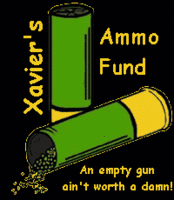





26 Comments:
WOW. I have no doubt that my next firearm purchase for myself will be a 1911. The time has simply come.
Now, I'm wondering if a used 1911 might be more of a possibility than before.
Food for thought. Thanks!
tweaker
Very well written and comprehensive, sir. I've been examining and buying used 1911-series pistols for closer to fifty years than forty. I just wish I'd such a set of instructions when I was first getting started. Lacking them, I made several noteworthy mistakes in judgement.
Not only are your technical pointers excellent, but the tips on etiquitte are invaluable. When I started getting my own table at gun shows, it was a joy to deal with a knowledgeable and polite prospective purchaser, of whatever type arm. Conversely, I've become disgusted with rudeness and called off negotiations simply on that account. Ignorance is fine; we all had to learn somehow. A lack of simple courtesy is unacceptable.
Thanks for an outstanding effort.
JPG
Thanks for the points, Xav. I've been thinking about a 1911 Frankengun at my local FFL. It's a 1911A1 pattern with spur hammer and GI thumb safety. The slide says Remington and has some night sights installed. The frame is an Essex.
It feels and looks good. There is obvious holster wear on both slide and frame. Thumb safety works well and moves smoothly.
The asking price is $650. I might make a bid at a lower price. The down side is there is a new Para GI next to it for $100 less.
Now, if I could just find a Remington frame...
Great read! Thank you for that.
Some would disagree on releasing the slide on an empty clip. I have read that it could mess up your trigger mech.
Xavier another fine post! I never was shown the etiquette with buying a firearm and I appreciate the information.
Thanks for this post Xav. Most of the gun stores I go to do not have used handguns any more. Not sure why this is the case. Also, I have not found pawn shops in my area that get any decent guns - mostly junk that I wouldn't take for free. But, I live in hope and look forward to the day that I can use the information and advice that I have taken from your blog. pjk
Xavier,
Your writing is worth waiting for.
This a great posting! Thanks.
Thank you, Xavier for sharing your knowledge. I appreciate it very much.
I too am a used gun buyer. So far, I've only bought two used 1911s (a Gold Cup NM an an Officer's ACP). I used an earlier version of your guide posted some time ago, and all went well. Much of what you write about buying used handguns has been used when inspecting other bottom feeders I have added to my modest collection.
I'll keep a copy of this expanded version in my car from now on, just in case...
Best regards,
Gale H
Ahhhhhh.... Nice to se you again old friend. Nice article
Welcome back
P
Mr. X,
I have perused a majority of your postings and find that you have expanded my awareness and understanding in several areas. My current activity is to learn to shoot my new 1911 safely and proficiently from both a draw and low ready position.
For me the most informative and interesting of your posts has been in the area of 1911 topics. It is such an interesting firearm to learn to use properly and shooting a big caliber semi-auto is FUN.
When doing my research on the 1911 prior to purchase, I also ruled out the Schwartz firing pin safety as implemented in the Kimbers. However I do differentiate the Colt Series 80 as a better implementation of the concept.
As a longtime 1911 shooter and afficiando of the firearm you may already know of this gunsmith - Mars Armament in Utah. He does some very fine Colt tuneups and also at a reasonable price.
My choice was to buy a new Ed Brown and I am very pleased with it's accuracy, smooth crisp trigger break and the overall attention to details in fit and finish.
Thank you for taking your time to share your insights and opinions on firearms and the responsibilities associated with their ownership and use.
I was made aware of your website off of Todd's pistol-training website.
Respectfully,
Michael Watson
choclabs_mw@hotmail.com
"Check the frame for cracks at the beginning of the dustcover and the slide stop hole. Some guns with a hole where the rear of the slide stop enters the frame will be cracked in the frame rail above the hole. This is so common that many newer guns have the rail cut out here. A crack in this area is not a cause for alarm in a shooter, but can be a bargaining chip on the price. It is easily repaired by cutting out the crack."
Xavier, I found this very interesting, but I can't visualize what you're talking about. Do you have any pictures or illustrations that show it?
Antibubba
Thanks again for another tutorial on gun buying. I really try to follow your advice when buying.
A reader in Maryland
Nice.
Handy to read all the tests and such in one spot.
Very thorough.
I stole this. And I'm glad I did. Thanks for a definitive treatment on a theme which will doubtless prove beneficial to many prospective 1911-buyers.
Kansas Scout,
What you are doing is checking for hammer follow. I do not advise dropping the slide on an emptry chamber routinely.
XB
A point or two regarding the Colt Officers .45acp pistol.
If you are looking at one for "serious social purposes", and it has the original type of recoil spring plug, put a reverse style plug in it immediately. Most will require some metal to be filed from the rear of the spring tunnel to accommodate the flange on the back side of the new plug.
Colt's design was faulty, as the plug was so thin walled that it flexed at the little tab that locked it to the slide. This flexing causes metal fatigue, and at some point a triangular shaped piece, running from the front of the tab out both sides to the open back, will break out. This will launch your recoil spring and plug down range, leaving you with a non-functional gun.
Making the plug wall thicker might have interfered with the recoil spring, so Colt did nothing, most likely on advice of their lawyers and bean counters.
The shortest life I've seen for one of these plugs is about 400 rounds. Note, you CANNOT judge the condition of the plug while it is installed. Originally, I was told that the tab would peel off, and to keep an eye on it. Good theory, not fact. I looked at one, looked ok, one mag later the spring and plug headed for the bullet trap. That was when I found the broken piece
that clued me in on the actual failure mode.
The second point is that most of the reverse plug designs use a full length guide rod (FLGR). Unless you can weld up the hole in the front of the plug, or get creative in covering it, you are stuck using the rod to keep the recoil spring from working through it. They can be a PITA, but maybe not so much as in the Gov't model. One of my Lightweight Officers has a King's plug and rod setup in it, and has been 100% reliable.
A side benefit of using the reverse plug with a big flange on it is that shock buffs don't get shredded anymore by the slide, which enhances reliability.
A well written and comprehensive post. Wish you were along when I bought my first 1911.
Will, Clark makes a reverse plug for the Officer's that requires no modification, and uses the original spring and guide rod. It's a drop in part.
You can see it on my Colt Compact.
I have not ever seen the recoil plug fail on the Officer's pistol, but I replaced mine as a matter of course. $20.
Aren't those plugs available via Brownells? I seem to remember seeing some like that in their catalog. My OCP-style 1911 is a Para and has a full-length guide rod. It's not difficult to strip but you do need both hands.
Thanks for the tip about Clark's parts for the Officers. I've got a couple more as long term projects, so I'll look at them.
Might see about swapping one into my steel frame, as that has one of the temporary fixes for the hole that I mentioned. I was pressed for time, trying to get set for a class. Took a SS Phillips head screw (the plug is SS), beveled the edge of the head to match the internal profile of the reverse plug I had, cut off the shank, and dropped it into the plug. Had to shorten the stock spring guide to clear the screwhead, but it has worked fine for about 14 years. I picked the screw because the screwdriver slots made it look as if it belonged there. Although, now, I think a straight slot might look better than the cross slots. Anyway, keeps the spring inside, which is the important thing.
It just occurred to me that the Wolf springs may have aggravated the breaking plug problem. IIRC, my original plug in the steel frame lasted about 8k rounds. I think I swapped in a HD Wolf spring with the replacement plug (factory Colt part). Gone after 400 rounds. The Lightweight model ran maybe 2k before spitting out the plug, and somewhere in there I had put in a Wolf spring. They are 24lb rated, IIRC. Stock double spring setup is 22lbs.
Voynaimir, we understand that slaves aren't allowed to own weapons. We fought a war some 150 years ago and freed our slaves. To bad the UK has turned their free men into slaves.
When you don't have the right to self-defense, you're property of those who've taken that right from you.
IF everything looks mechanically correct, there's one thing I'd advocate looking into:
It is useful to know, if a 1911 has been "tuned", what loadings it was tuned for. My 3" Micro-Compact was built by me around the intent to shoot 200 grains. My personal preferences for a micro-compact. Lots of springs were played with to make it run the 200 grain loads that it was built for. For a while it was tailored to 165s. Both changes caused significant fiddling with springs and if I was going to re-aim it to shoot 230 grain, I'd have to change springs around again.
So, feed malfs (or battering during cycling) might not be the fault of a well put together 1911 with standardish ammo if somebody built it around a particular load he intended to use other than what you bought off the shelf to test it before you buy.
This finickiness is even worse in my experience with .38 Supers and .38-45 Clarkes I've run into over the years, if it's a target/practical/specialized carry gun, it helps to know what it was designed to eat. If you have different tastes than the previous owner in loading choices, it's just a matter of fiddling with springs till it reliably eats what YOU want it to eat, it's not necessarily the fault of it being a bad gun if you get malfs with standard ammo it wasn't intended to eat.
It's seriously useful to buy from the actual last user of a 1911 rather than a gunshop used 1911 of unknown provenance, as you can get a better idea of what reasons things were done for and why it may or may not need to be re-smithed to suit your plans for it.
A gun showed up in a local shop that was done by a friend of mine for a particular customer's tastes and the gun shop owner was horrified by it's function, as purchased, because he didn't know what it was built to do. True stories of the 1911...
Not related to 1911s, but related to used firearms:
For what it's worth, it's also useful to know past history with gas-guns, as a gas gun regulated to a different load than what you put in it will either batter itself to death or short-cycle.
People will argue until the end of time as to if regulating a firearm for oddball loadings compared to off the shelf stuff is a good idea, but people still DO DO IT and it doesn't need ruin a firearm.
I know it has been a while since your original post, but I'll ask and hopefully you'll comment:
How much slide/barrel lug peening is too much?
I'm not buying - I'm just trying to determine whether I should do something about my Series '70 Combat Commander that seems very peened, yet shoots fine.
Stuart, I would come close to saying any. It will just get worse over time. Contact marking is OK. Metal deformation due to parts slamming together isn't. the gun may shoot fine now, but the question is how long it will last.
If I only had this information before I bought my first 70 Series Gold Cup National Match more than a few years ago. Great post!
ainfantry7
Post a Comment
<< Home